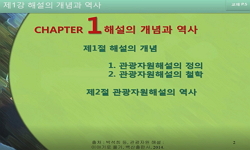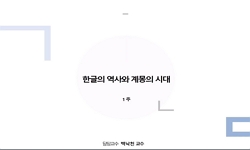본고는 한글 맞춤법의 해설인 국립국어원(2018)을 국어연구소(1988)과 비교해서 어떤 차이가 있는지 검토했다. 한글 맞춤법 규정은 1988년 고시와 2017년 고시가 큰 차이가 없다. 부분적으로 변한...
http://chineseinput.net/에서 pinyin(병음)방식으로 중국어를 변환할 수 있습니다.
변환된 중국어를 복사하여 사용하시면 됩니다.
- 中文 을 입력하시려면 zhongwen을 입력하시고 space를누르시면됩니다.
- 北京 을 입력하시려면 beijing을 입력하시고 space를 누르시면 됩니다.
https://www.riss.kr/link?id=A107871865
- 저자
- 발행기관
- 학술지명
- 권호사항
-
발행연도
2021
-
작성언어
Korean
-
주제어
한글 ; 맞춤법 ; 소리 ; 어법 ; 해설 ; 원형 ; Hangeul ; orthography ; sound ; commentary ; grammar ; original form
-
등재정보
KCI등재
-
자료형태
학술저널
- 발행기관 URL
-
수록면
25-58(34쪽)
-
KCI 피인용횟수
0
- 제공처
-
0
상세조회 -
0
다운로드
부가정보
국문 초록 (Abstract)
1988년의 해설은 전문적인 언어학 용어의 사용을 통한 학문적 설명에 치중했다면 2018년의 해설은 상대적으로 쉬운 표현을 통해 언중들에게 본문 규정을 이해시키려고 했다. 해설의 텍스트 구성을 둘로 나누어서 조금 더 전문적인 내용이나 부연 설명할 내용은 ‘더 알아보기’에서 다루었다. 용어에 대한 설명은 ‘더 알아보기’로 옮겨서 기술하였다. 또한 표를 사용해서 시각적으로 독자들이 쉽게 본문의 내용을 확인할 수 있도록 했다.
88년 해설에서 총칙 제1항의 ‘소리대로’와 ‘어법에 맞도록’을 원칙과 조건으로 이해했다면 18년 해설에서는 전자와 후자 모두 원칙으로 판단하였다. 구체적인 조항에서는 장황한 기술을 간략하게 바꾸는 방향으로 해설을 수정했다. 기존 해설이 언어학적인 설명을 위해 방만한 내용으로 구성되었다면 이해하기 쉽게 하위 주제별로 텍스트를 구성해서 제시한 경우가 많았다.
본고는 한글 맞춤법의 해설인 국립국어원(2018)을 국어연구소(1988)과 비교해서 어떤 차이가 있는지 검토했다. 한글 맞춤법 규정은 1988년 고시와 2017년 고시가 큰 차이가 없다. 부분적으로 변한 규범을 반영해서 수정한 것 외에는 큰 틀에서는 차이가 없다. 그러나 해설은 1988년의 해설과 2018년의 해설이 규정의 변화에 비해서는 변화의 폭이 크다고 할 수 있다.
1988년의 해설은 전문적인 언어학 용어의 사용을 통한 학문적 설명에 치중했다면 2018년의 해설은 상대적으로 쉬운 표현을 통해 언중들에게 본문 규정을 이해시키려고 했다. 해설의 텍스트 구성을 둘로 나누어서 조금 더 전문적인 내용이나 부연 설명할 내용은 ‘더 알아보기’에서 다루었다. 용어에 대한 설명은 ‘더 알아보기’로 옮겨서 기술하였다. 또한 표를 사용해서 시각적으로 독자들이 쉽게 본문의 내용을 확인할 수 있도록 했다.
88년 해설에서 총칙 제1항의 ‘소리대로’와 ‘어법에 맞도록’을 원칙과 조건으로 이해했다면 18년 해설에서는 전자와 후자 모두 원칙으로 판단하였다. 구체적인 조항에서는 장황한 기술을 간략하게 바꾸는 방향으로 해설을 수정했다. 기존 해설이 언어학적인 설명을 위해 방만한 내용으로 구성되었다면 이해하기 쉽게 하위 주제별로 텍스트를 구성해서 제시한 경우가 많았다.
다국어 초록 (Multilingual Abstract)
The purpose of this paper is to examine the difference between the National Institute of Korean Language (2018), a commentary of Korean spelling, and the Korean Language Institute (1988), a commentary of Korean spelling. The Korean spelling rules do n...
The purpose of this paper is to examine the difference between the National Institute of Korean Language (2018), a commentary of Korean spelling, and the Korean Language Institute (1988), a commentary of Korean spelling. The Korean spelling rules do not differ much between the 1988 version and the 2017 version. There is no difference in the framework except for the modification of partially changed norms. However, the commentary in 1988 and the commentary in 2018 can be said to have a wide range of changes compared to the changes in regulations. While 1988"s commentary focused on academic explanations of the regulations through the use of professional linguistic terms, 2018"s commentary tried to make users understand the writing regulations through relatively easy expressions. However, the use of terminology has not been significantly reduced due to the limitations in easily conveying theoretical explanations of the content of spelling. The text structure of the 1988"s commentary was divided into two, rules and the explanation about the rules. The text structure of the 2018"s commentary was also divided into two but some of the explanations have additional annotations. the 2018 commentary provides some tables to help readers to understand rules easily. There is a change of perspective between the 1988 commentary and the 2018 commentary about the article 1 of the general rule. In the former the principle of Korean orthography is phonemic writing and the morphological consideration is a kind of condition of the principle. However according to the 2018 commentary there are two principles in Korean orthography, Those are the phonemic writing and the morpho-phonemic writing. Compared to the 1988 commentary, the 2018 commentary has changed briefly and has changed to be easier to understand. Compared to the description of the 1988 commentary, the description of the 2018 commentary has changed to be easier to understand. However, if there is a problem with the contents of the text, there is no room for full improvement in the commentary, so it is not better than the commentary in 1988.
목차 (Table of Contents)
- 국문 요약
- 1. 머리말
- 2. 2018 해설의 전체적 특성
- 3. 2018 해설의 조항별 고찰
- 4. 맺음말
- 국문 요약
- 1. 머리말
- 2. 2018 해설의 전체적 특성
- 3. 2018 해설의 조항별 고찰
- 4. 맺음말
- 참고문헌
- Abstract
참고문헌 (Reference)
1 김상태, "형태자소적 쓰기" 한국중원언어학회 4 : 47-61, 2000
2 김정남, "한글맞춤법의 원리 -총칙 제1항의 의미 해석을 중심으로-" 한국어의미학회 27 : 21-44, 2008
3 박창원, "한글맞춤법 총칙 제1항의 음운론(2) - ‘어법’으로 표출된 공시태와 통시태 -" 이화어문학회 (40) : 101-134, 2016
4 박창원, "한글맞춤법 총칙 제1항의 음운론(1) - ‘소리’라는 존재의 본질과 실재 -" 언어정보연구소 27 : 171-208, 2016
5 김주필, "한글맞춤법 원칙의 특성과 의미" 국민대학교 어문학연구소 24 : 87-107, 2005
6 정희창, "한글 맞춤법의 비판적 검토와 개정 방향" 우리말글학회 65 : 29-46, 2015
7 국어연구소, "한글 맞춤법 해설"
8 국립국어원, "한글 맞춤법 표준어 규정 해설"
9 이선웅, "한글 맞춤법 총칙 제1항과 일부 조항에 대한 검토" 국어교육학회(since1969) (58) : 225-252, 2015
10 일석이희승전집간행위원회, "이희승 전집 3 - 한글맞춤법통일안강의(전자책)" 서울대학교출판부 2006
1 김상태, "형태자소적 쓰기" 한국중원언어학회 4 : 47-61, 2000
2 김정남, "한글맞춤법의 원리 -총칙 제1항의 의미 해석을 중심으로-" 한국어의미학회 27 : 21-44, 2008
3 박창원, "한글맞춤법 총칙 제1항의 음운론(2) - ‘어법’으로 표출된 공시태와 통시태 -" 이화어문학회 (40) : 101-134, 2016
4 박창원, "한글맞춤법 총칙 제1항의 음운론(1) - ‘소리’라는 존재의 본질과 실재 -" 언어정보연구소 27 : 171-208, 2016
5 김주필, "한글맞춤법 원칙의 특성과 의미" 국민대학교 어문학연구소 24 : 87-107, 2005
6 정희창, "한글 맞춤법의 비판적 검토와 개정 방향" 우리말글학회 65 : 29-46, 2015
7 국어연구소, "한글 맞춤법 해설"
8 국립국어원, "한글 맞춤법 표준어 규정 해설"
9 이선웅, "한글 맞춤법 총칙 제1항과 일부 조항에 대한 검토" 국어교육학회(since1969) (58) : 225-252, 2015
10 일석이희승전집간행위원회, "이희승 전집 3 - 한글맞춤법통일안강의(전자책)" 서울대학교출판부 2006
11 정희창, "우리말 맞춤법 띄어쓰기" 랜덤하우스 2007
12 Rogers, Henry Edwin, "언어학의 풀어본 문자의 세계" 역락 2007
13 Dürscheid, Christa, "문자 언어학" 유로 2007
14 구본관, "맞춤법 교육 내용 연구 - 한글 맞춤법의 원리를 중심으로-" 한국어교육학회 (127) : 195-232, 2008
15 이익섭, "국어 표기법 연구" 서울대학교 출판부 1992
16 민현식, "국어 정서법 연구" 태학사 1999
17 박용찬, "‘한글 맞춤법’의 원칙 및 원리에 대한 재고찰" 한국어문학회 (147) : 41-72, 2020
18 허철구, "‘한글 맞춤법’의 원리에 대한 일고" 한중인문학회, 사림어문학회 17 : 183-195, 2007
19 정희창, "‘한글 맞춤법 해설’의 분석과 발전 방향" 반교어문학회 (48) : 13-31, 2018
20 이지수, "‘한글 맞춤법 해설(2018)’의 개정 내용 분석 및 교육적 활용 방안" 반교어문학회 (51) : 147-168, 2019
21 신지연, "<한글맞춤법> ‘소리대로 적되’의 의미" 국어학회 (92) : 3-36, 2019
22 최형용, "<한글 맞춤법> 총칙 제1항과 표기의 원리" 한중인문학회 (26) : 167-184, 2009
23 국립국어원, "2014 고시 한글 맞춤법 2017 고시 한글 맞춤법 비교"
24 국립국어원, "1988 고시 한글 맞춤법 2014 고시 한글 맞춤법 비교"
동일학술지(권/호) 다른 논문
-
- 우리말글학회
- 장경현(Jang, Gyeong-hyeon)
- 2021
- KCI등재
-
베트남어권 한국어 학습자의 비즈니스 요청 화행의 수행 분석
- 우리말글학회
- 정미진(Jung, Mijin)
- 2021
- KCI등재
-
2015 개정 교육과정에 따른 『문학』 교과서의 ‘세계문학 교육’에 대한 비판적 고찰
- 우리말글학회
- 고지혜(Ko, Ji-hye)
- 2021
- KCI등재
-
한국현대시문학사 교육의 현황과 과제 - 고등학교 ≪문학≫ 교과서의 문학사 단원 분석을 중심으로 -
- 우리말글학회
- 김정우(Kim, Jung-woo)
- 2021
- KCI등재
분석정보
인용정보 인용지수 설명보기
학술지 이력
| 연월일 | 이력구분 | 이력상세 | 등재구분 |
|---|---|---|---|
| 2026 | 평가예정 | 재인증평가 신청대상 (재인증) | |
| 2020-01-01 | 평가 | 등재학술지 유지 (재인증) |  |
| 2017-01-01 | 평가 | 등재학술지 유지 (계속평가) |  |
| 2013-01-01 | 평가 | 등재 1차 FAIL (등재유지) |  |
| 2010-01-01 | 평가 | 등재학술지 유지 (등재유지) |  |
| 2008-01-01 | 평가 | 등재학술지 유지 (등재유지) |  |
| 2005-05-27 | 학술지명변경 | 외국어명 : Urimalgeul -> Urimalgeul: The Korean Language and Literature |  |
| 2005-01-01 | 평가 | 등재학술지 선정 (등재후보2차) |  |
| 2004-01-01 | 평가 | 등재후보 1차 PASS (등재후보1차) |  |
| 2003-01-01 | 평가 | 등재후보학술지 선정 (신규평가) |  |
학술지 인용정보
| 기준연도 | WOS-KCI 통합IF(2년) | KCIF(2년) | KCIF(3년) |
|---|---|---|---|
| 2016 | 0.58 | 0.58 | 0.6 |
| KCIF(4년) | KCIF(5년) | 중심성지수(3년) | 즉시성지수 |
| 0.54 | 0.53 | 1.033 | 0.17 |




 DBpia
DBpia






